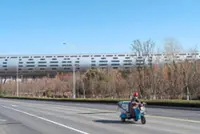An aerial drone photo taken on Feb 3, 2024 shows a container terminal of Tianjin Port in North China's Tianjin. Tianjin Port, located on the coast of the Bohai Sea, is a major shipping point in North China. [Photo/Xinhua]
THIS year marks the 10th anniversary of the Jing-Jin-Ji (Beijing-Tianjin-Hebei) coordinated development plan and the seventh anniversary of the establishment of the Xiong’an New Area, or the “city of the future”, in Hebei province.
In early 2014, the Chinese top leader urged Beijing, Tianjin and Hebei province to explore a sustainable development path, leveraging respective complementary strengths, which would yield mutual benefits.





